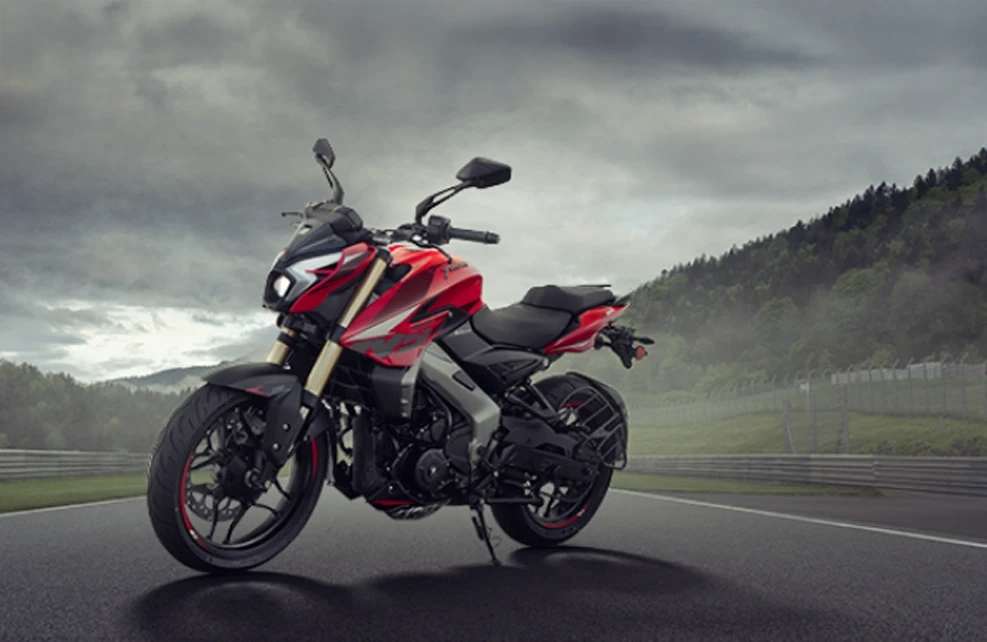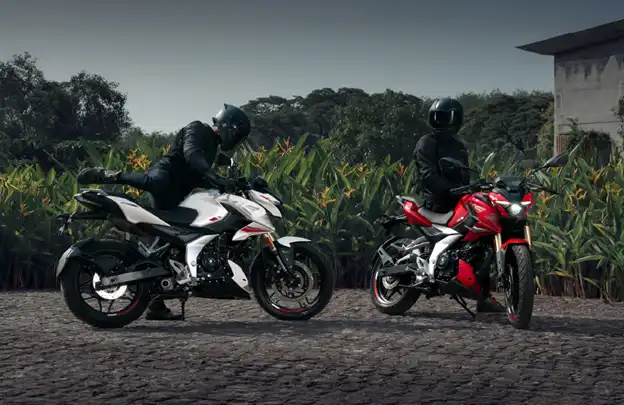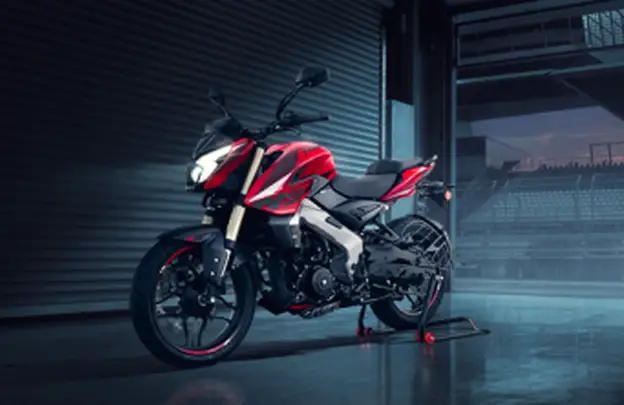
Choose your Country

Choose your Country
Last Updated: August 01 2025

If you're in the market, looking for a Bajaj motorcycle that fits Sri Lankan roads and your daily riding style, chances are you’ve come across both the Pulsar N125 and the NS400. They look sharp, sound powerful, and have their own way of turning heads. But which one is really for you?
Both come from the same trusted badge. Both look bold on the road. But they’re clearly built for different riders.
If you’re trying to figure out which one suits your daily ride, this comparison might help. We’ve broken things down in a way that’s easy to understand. We’ve broken down all the things that matter when you’re riding in real traffic, on real roads, across Sri Lanka.
This blog will walk you through every comparative detail, starting with power, design, handling, features, and of course, the Pulsar bike price in Sri Lanka, so you can decide which one suits your journey better.
Find your new best friend in a Bajaj bike to conquer the roads with.
Contact your nearest Bajaj dealer.
When you talk about power, there’s no question that the Bajaj Pulsar NS400 Z takes the crown. With a 373.27cc engine producing 40 PS @ 8500 rpm and 35 Nm of torque, this is the most powerful Pulsar ever launched in Sri Lanka.
It’s a machine for riders who like to push a little harder. Whether you're cutting through traffic or taking a longer route through the hill country, the NS400 feels sharp and responsive. The throttle answers fast, and that Assist & Slipper Clutch makes gear shifts smooth, even during hard downshifts.
Now the Pulsar N125 is built for a different kind of ride. It has a smaller 124.59cc engine, but don’t let the size fool you. It delivers 12 PS of power and 11 Nm of torque and is one of the quickest among the models.
That makes it ideal for riders who deal with traffic, narrow roads, or just want to zip across town without effort.

The NS400 feels planted. It’s got 43mm USD forks at the front and a Nitrox monoshock at the back. These give you better control when braking hard or going over uneven roads. And with three riding modes (Road, Rain, and Off-Road) that you can actually switch based on the kind of road you’re on. That’s not just a spec. It changes how the bike responds under your hands.
Meanwhile, the Pulsar N125 keeps things simple but effective. 25mm telescopic front suspension, rear monoshock, and a body that weighs just 125 kg. You feel the difference the moment you take a U-turn or swerve through Galle Road traffic.
It’s light, easy to control, and doesn’t make you work too hard, even when the road gets tight.

Both bikes look sharp, no question. However, they convey very different vibes.
The NS400 has that muscular streetfighter stance. From the lightning bolt DRLs to its floating body panels, the design gives it a serious, powerful look. It’s got a short wheelbase and wide tyres, so it feels low and ready to launch.
The Pulsar N125 plays it differently. It’s more youthful. It’s got hexagonal graphics, bright colour schemes, and a lighter frame that feels fun, not aggressive. You’ll spot this bike often around campuses, offices, or quick evening rides. It’s designed to look cool but not intimidating.
The NS400 is packed with modern features. You get a Bluetooth-connected LCD display, Turn-by-Turn navigation, and ride data that shows more than just your speed. Even the headlamp is a bi-functional LED projector, built to give better visibility on darker roads or during night rides in the hill country.
The N125 keeps things practical. You still get Bluetooth connectivity in select variants, a USB charging port, and digital fuel and trip readouts. Enough for city riding, with a touch of smartness where it counts.
The NS400 gives you dual-channel ABS, traction control, and the flexibility to switch your brake response with ride modes. It adjusts how the ABS kicks in (less in Off-Road mode, more in Rain mode). That’s handy when you’re riding through wet Colombo roads or rural gravel patches.
On the N125, the setup is simple but well-tuned. You get a 240 mm front disc and 130 mm rear drum, paired with CBS (Combined Braking System). It balances the brake across both wheels, especially helpful during sudden stops.
Also worth noting is the ground clearance. The N125 stands high at 198 mm, making it easy to clear potholes, village tracks, and uneven city roads without scraping the underbody.
The NS400 is built for more serious rides. The seat is firm and wide. The riding posture leans a bit forward. You feel in control, but after a longer ride, it still keeps your back and wrists from getting tired.
The N125 offers a more upright stance. You don’t lean forward much, so it feels natural in start-stop traffic. The seat height is 795 mm, easy for most riders to plant both feet. It’s a bike that feels easy from the first ride.
Here’s a breakdown of both the Pulsar NS400 and Pulsar 125 prices in Sri Lanka:
That’s a big gap. But the bikes are also meant for different buyers. One is built for daily commuting and short hops. The other is made for power rides, weekend getaways, and riders who want a bit more from their machine.
It’s less about which is cheaper and more about what kind of rider you are.
Choose the Pulsar N125 if you ride mostly in the city and want a bike that’s fast enough for short trips, is easy to handle, and light on the wallet. Ideal for students, new riders, and daily commuters, this model is for those who like riding, but don’t bank on high performance every day.
On the other hand, go for NS400 if you’ve been riding a while and you want more power, better tech, and a ride that adapts to different roads. This bike will serve you well for those weekend rides where features like ride modes, Bluetooth nav, or better brakes will come in handy. By investing in this model, you’re investing in performance and not just transport.
Both bikes wear the Pulsar name, and both deliver what they promise. But they’re clearly made for different journeys.
The NS400 gives you the feel of a premium streetfighter. Power, control, and features you don’t find in most bikes in its segment. It’s serious about performance while the Pulsar N125 keeps it fun and functional. It’s light, smooth, and built for city riders who want just enough of everything to make daily rides enjoyable.
It comes down to what you ride for and how far you want your bike to take you.
Contact us today to learn more about these two models.
1. Which bike is easier to handle in city traffic?
The Pulsar N125 is lighter and more agile. Its quick 0–60 km/h pickup and compact design make it great for weaving through traffic.
2. Does the NS400 come with different ride modes?
Yes. NS400 offers Road, Rain, and Off-Road modes, allowing you to adjust ABS and throttle response to suit your ride conditions.
3. Which Pulsar is better for long-distance rides?
The NS400 is more suitable for long rides due to its power, comfort, and advanced suspension setup.
4. Is the N125 fuel-efficient?
Yes, it’s designed with city usage in mind and offers good economy as suggested by many Pulsar N125 owners.
Bajaj Bikes in Sri Lanka: Smart Choices for Everyday Journeys
Know More
Is the Bajaj Discover 125 a Worthwhile Investment for the Long Run?
Know More
Speed Meets Elegance: The Rise of Performance Bikes in Colombo’s Youth Scene
Know More
Is the Bajaj Discover 125 the Ideal Commuter for Galle's Lively Roads?
Know More
5 Features That Put the NS400 Z on Every Performance Lover’s Wishlist
Know More
Bajaj CT 100 Price and Competition: Performance Riding within Your Budget
Know More
Beyond the City Limits: The Discover 125 Bajaj's Performance on Sri Lanka's Rural Roads (Kandy & Matara)
Know More
Bajaj CT 100 Price vs. Rivals: How It Stacks Up Against Other 100cc Bikes in Sri Lanka
Know More
Built for the Bold: How the Bajaj Pulsar Conquers Colombo and Climbs Kandy
Know More
Pulsar N160 in Sri Lanka: Unveiling the New Flagship and Its Impact on Local Enthusiasts
Know More
Redefine Every Ride: Pulsar N160’s Mileage and Muscle for Sri Lankan Adventures
Know More
Unleashing the Beast: Why the Pulsar NS400 Z is the Ultimate Power Bike for Sri Lanka’s Young Riders
Know More
City Racer’s Dream: How the Bajaj Pulsar NS200 Delivers Thrill and Speed in Urban Chaos
Know More
Bajaj Bikes 2025: Unlock Your Ride – Complete Price List, Features & Buying Guide
Know More
Bajaj Pulsar 2025: Your Ultimate Value-for-Money Buying Guide
Know More
Bajaj Discover 125 in Sri Lanka: Top Features That Make it a Commuter Favourite
Know More
Bajaj Discover 125 vs. Rivals: Performance and Features in Sri Lanka's 125cc Segment
Know More
Riding Smart: How Bajaj Pulsar N160 Balances Style, Safety & Performance
Know More
Efficiency Meets Endurance: The Bajaj Discover 125 for Daily Travelling
Know More
7 Reasons the Pulsar NS400 Z Outclasses Its Rivals in the 400cc Segment
Know More
Ride Smart: How the Pulsar NS400Z's Riding Modes Adapt to Your Journey
Know More
Why Riders Swear by the Pulsar NS200: A Deep Dive into Its Best Features
Know More
Why the Pulsar NS200 Black Is the Ultimate Street Icon for Colombo’s Young Riders
Know More
7 Essential Maintenance Tips for Your Sports Bike to Increase Its Life
Know More
The Community Workhorse: What the CT 100 Means to Everyday Riders
Know More
Thinking of Buying the Pulsar NS200 in Sri Lanka? Read This First
Know More
CT 100 ES Review: Mileage, Features & Why It’s Built for Sri Lanka's Roads
Know More
From Potholes to Packed Streets: Discover 125 Can Take It All
Know More
The Pulsar NS & N Series: What Sets Them Apart From the Rest?
Know More
5 Reasons the Bajaj CT 100 Is the Best Investment for Your Side Hustle
Know More
Your Complete Guide to Bajaj Bikes in Sri Lanka: Models, Prices, and Where to Buy
Know More
Bajaj Pulsar Series in Sri Lanka: Unveiling the Thrill
Know More
Fuel Efficiency and Affordability: Why Discover Bike Dominates Sri Lanka's Commuter Market
Know More
Buying a Used Bajaj Bike in Sri Lanka: Smart Tips for a Reliable Purchase
Know More
Factors Influencing Bajaj Motorcycle Price: What You Need to Know Before Buying
Know More
Why Small Business Owners Trust the Bajaj CT 100
Know More
Built for Business: Why the Bajaj CT 100 is the Ultimate Partner for Daily Earners
Know More
Driven by Value: Best Bikes for Ambitious Youth in Sri Lanka
Know More
From Colombo to Jaffna: A Journey Best Taken on the Pulsar NS400Z
Know More
Agile & Efficient: How the Pulsar N125 Conquers Negombo Traffic
Know More
Optimising Fuel Efficiency for CT 100: Riding Habits That Make a Difference
Know More
Choosing Your Thrill: A Guide to Bajaj Pulsar Models in Sri Lanka
Know More
Bajaj in Sri Lanka: A Legacy of Trust and Innovation on Island Roads
Know More
Buying a Bajaj in Sri Lanka: New vs. Used & Financing Options
Know More
What Makes the Pulsar N160 Engine Ideal for Mixed Terrain Riding?
Know More
Built for Our Roads: Why the Pulsar N160 Feels So Right at Home in Sri Lanka
Know More
Why the Pulsar N160 Turns Heads Without Even Trying
Know More
Crush Weekend Rides to Kandy in Style with the Pulsar NS200
Know More
Bajaj Bike Prices in Sri Lanka: Top Finds Under Your Budget
Know More
How the CT 100 ES Electric Start Makes Office Commutes Easier
Know More
Bajaj’s ExhausTEC Explained: How It Improves Torque and Pickup
Know More
Top Bajaj Bikes for Delivery Riders in Colombo and Suburban Areas
Know More
Bikes Price in Sri Lanka 2025: Why Bajaj Models Offer Best Value
Know More
ABS in Pulsar N160: A Must-Have Feature for Urban Safety
Know More
What Makes the Bajaj CT 100 One of the Most Fuel-Efficient Bikes in Sri Lanka
Know More
Bajaj New Bike Price in Sri Lanka: What to Expect in 2025
Know More
Bajaj Motorcycle Price in Sri Lanka: Complete 2025 Guide
Know More
Pulsar N160 Performance Review: Ideal for City Streets and Long Routes?
Know More
Pulsar N160 vs Pulsar NS200: Detailed Comparison for Sri Lankan Riders
Know More
CT100 ES: Sri Lanka's Most Affordable Bike for Daily Commutes
Know More
5 Reasons Why Discover 125 Is Perfect for Business Use in Sri Lanka
Know More
Stylish and Street-Smart: Is the Pulsar N160 Right for You?
Know More
Pulsar N125: The Perfect First Bike for Young Riders in Sri Lanka
Know More
What Makes Pulsar N160 Dual FI ABS Stand Out in Style & Safety?
Know More
Pulsar NS200: The Ultimate City Sportbike for Young Riders in Sri Lanka
Know More
Bajaj CT 100: Sri Lanka’s Homegrown Champion for Reliable Commuting
Know More
Introducing the Iconic Bajaj Pulsar N160 Dual ABS: Your Partner for Countless Adventures Across Sri Lanka
Know More
20 Years & Counting: Exploring Why the CT 100 Remains Sri Lanka’s #1 Commuter Bike
Know More
Bajaj Discover 125: Top 5 Features That Make the Bajaj 125 Perfect for Riders in Sri Lanka
Know More
Discover 125 Price in Sri Lanka: Is This the Best 125cc Bike for You?
Know More
The Bajaj Advantage: How ExhausTEC Makes City Riding Effortless
Know More
Top Riding Habits That Will Extend the Life of Your Bajaj Motorcycle
Know More
Understanding ABS in Bajaj Bikes: Why It Matters for Safe Riding in Sri Lanka
Know More
What Is Bajaj DTS-i Technology and How Does It Improve Your Engine Performance?
Know More
Bajaj Pulsar N160: A Beginner’s Guide to Sri Lanka’s Sporty Commuter
Know More
Bajaj CT 100 ES: A Budget-Friendly Bike with Great Performance
Know More
Bajaj Discover 125 – The Perfect Feature-packed Bike for Exploring Vibrant Colombo Streets
Know More
Top 125cc Bikes in Sri Lanka: The Perfect Balance of Power and Fuel Efficiency
Know More
Power Meets Durability: How Bajaj Bikes Outperform on Sri Lanka’s Toughest Roads
Know More